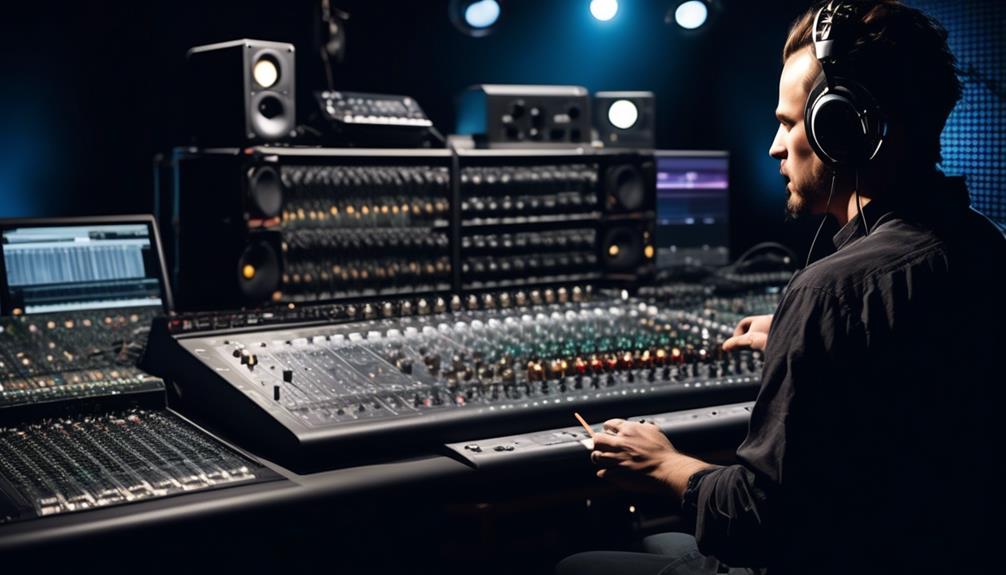Field recording, exemplified by the work of acclaimed sound artist Chris Watson recording the sounds of the Amazon rainforest, is a crucial tool in capturing the essence of our environment.
But what exactly is the purpose of venturing out into the field to capture audio? While the answer might seem straightforward, the depth of field recording's significance goes far beyond simply collecting sounds.
It encompasses a realm of creativity, authenticity, and exploration that is essential for various industries and individuals.
Key Takeaways
- Field recording serves multiple purposes, including contributing to sound libraries and acoustic ecology, enhancing multimedia projects, inspiring creativity and inspiration, and preserving audio heritage.
- Specialized equipment and techniques, such as omnidirectional microphones and various recording techniques, are used to capture authentic and diverse sounds.
- Field recording can elevate the audio experience in multimedia projects, such as video games, films, and virtual reality, by providing realistic soundscapes.
- Field recording also plays a crucial role in documenting and preserving cultural and natural soundscapes, including traditional music, languages, and environmental soundscapes, for future generations.
Capturing Environmental Ambiance
Capturing environmental ambiance through field recording involves the precise documentation of natural and human-produced sounds, electromagnetic fields, and vibrations using high-quality equipment and innovative techniques. Field recordists employ specialized audio recorders, omnidirectional microphones, and stereo recording techniques to capture audio that faithfully represents the natural soundscapes. These recordings serve as invaluable resources for sound libraries, providing authentic and diverse material for various applications in audio production.
The utilization of omnidirectional microphones enables the capture of a 360-degree sonic environment, ensuring the faithful reproduction of the spatial characteristics of the recording location. Additionally, the stereo recording technique, employing two microphones arranged to simulate human hearing, allows for the preservation of the directional and distance cues present in the original sound source, providing a more immersive listening experience.
The meticulous capturing of environmental ambiance not only enriches sound libraries but also fosters a deeper connection with the natural world. It allows for the preservation of unique sonic environments and offers an opportunity for individuals to experience and appreciate the beauty of natural acoustics. Furthermore, these recordings can be utilized in various artistic and practical applications, ranging from music production to the creation of immersive sound installations and multimedia artworks.
Documenting Cultural and Natural Soundscapes

Documenting cultural and natural soundscapes involves meticulously capturing the unique auditory characteristics of specific locations, encompassing both the ambient sounds of the environment and the culturally significant sonic elements present within it. Field recording serves as the primary method for documenting these soundscapes, utilizing high-quality recording equipment to capture a diverse range of sounds. The practice of documenting cultural and natural soundscapes contributes to the field of acoustic ecology, providing valuable source material for sound designers and researchers.
By using field recordings, sound designers can access authentic sounds that enhance their projects, contributing to the creation of immersive auditory experiences. The process involves employing various recording techniques, such as A/B, XY, M/S, as well as innovative methods like creative microphone placement and sound diffusion, to accurately capture the acoustic environments. This meticulous approach ensures that the documented sounds faithfully represent the cultural and natural characteristics of specific locations.
Documenting cultural and natural soundscapes not only enriches sound libraries but also provides opportunities for individuals to explore diverse sonic environments, contributing to their mental well-being. It allows for a deeper connection with the environment and serves as a form of mindfulness, offering a break from the digital world. Ultimately, documenting these soundscapes through field recording offers a wealth of opportunities for creativity, research, and the preservation of cultural sonic heritage.
Enhancing Multimedia Projects
Field recording enhances multimedia projects by providing a diverse range of authentic and immersive sounds to elevate the overall audio experience. It allows for the creation of realistic soundscapes, adding depth and richness to multimedia content. Incorporating high-quality, natural sounds through field recording enhances the overall audio experience, making the content more engaging and captivating. This can be particularly beneficial for video games, films, virtual reality experiences, and other multimedia projects where audio plays a crucial role in creating a sense of immersion and realism.
| Field Recording Tools | Description |
|---|---|
| Contact Microphones | Capture vibrations and acoustic signals from solid surfaces, offering unique sound perspectives |
| Stereo Recordings | Create a sense of spatial realism, capturing the ambiance and location of the recorded sounds |
| Digital Audio Recorders | Enable high-quality, portable audio recording, suitable for capturing a wide range of sounds |
| Sound Libraries | Provide a vast collection of sound effects and ambient recordings for use in multimedia projects |
Fostering Creativity and Inspiration

Fostering creativity and inspiration in the realm of field recording entails engaging with the sonic environment to cultivate innovative approaches to sound capture.
Field recording offers a wealth of opportunities for creativity, inspiring fresh perspectives on the audio-visual experience.
The use of specialized microphones, such as omnidirectional microphones, allows for the capture of a wide range of sounds, fostering an environment where unique recording experiences can drive creative processes.
Whether recording indoors or outdoors, the diversity of sonic environments presents a myriad of possibilities for inspiration.
Moreover, the creative process in field recording isn't limited to traditional soundscapes.
ASMR videos and the exploration of unusual objects can spark inventive ideas, propelling the development of new techniques and expanding artistic expression.
These recordings find use in a variety of multimedia projects, including film, where they can evoke powerful emotional responses and enhance storytelling.
Ultimately, the process of professional field recording promotes constant experimentation and innovation, nurturing an environment where the boundaries of creativity are continuously pushed, leading to the development of new and exciting sonic experiences.
Preserving Audio Heritage
Preserving audio heritage is a critical endeavor that builds upon the creative processes and innovative techniques inherent in field recording, ensuring the conservation of cultural and environmental soundscapes for future generations.
Through the art of field recording, sounds are captured using various equipment such as the Sennheiser MKH series, which excels in capturing environmental and ambient sounds with exceptional clarity and precision.
This process, rooted in the pioneering work of individuals like Ludwig Koch and Pierre Schaeffer, aims to document and safeguard traditional music, languages, and environmental soundscapes that may be endangered or at risk of disappearing.
The utilization of advanced techniques such as phonography and the implementation of specialized microphones like the Mid microphone enable the creation of a rich stereo image that authentically represents the sonic environment.
Preserving audio heritage through field recording not only safeguards these invaluable soundscapes but also makes them accessible to future generations, fostering a deeper understanding and appreciation of diverse sonic cultures and environments.
Frequently Asked Questions
Why Do People Do Field Recordings?
We do field recordings to capture the richness of environmental sounds, wildlife audio, urban ambiance, cultural traditions, historical preservation, soundscapes exploration, natural landscapes, industrial machinery, human interactions, and remote locations.
Field recording allows us to authentically collect and preserve these diverse sonic elements, enhancing sound libraries and providing unique, real-world sounds for creative projects.
It encourages exploration and creativity in the sonic world and can lead to careers in sound design and audio engineering.
Why Is Recording Important in Field Work?
Recording is vital in field work for documenting the authenticity of environments. It captures the natural ambience, preserving cultural traditions and historical significance.
Our research focuses on the importance of soundscapes in storytelling, especially in remote expeditions and wildlife habitats. The acoustic ecology of these areas is crucial for understanding and conservation.
Professional equipment ensures high-quality recordings, enhancing our ability to convey the immersive experience of these environments.
What Is the Difference Between Field Recording and Studio Recording?
Field recording requires specialized equipment like high-quality recorders, microphones, and pre-amplifiers to capture real-world sounds. Environmental challenges, such as unpredictable noise and weather, demand adaptability and technical skills.
Unlike studio recording, field recording offers creative freedom and authenticity, but requires meticulous location scouting. Capturing atmosphere and post-production processing enhance sound quality.
It's a balance of embracing the natural environment while utilizing technical expertise to produce high-quality recordings.
What Are Different Types of Field Location Recording?
Different environments, wildlife sounds, urban landscapes, natural ambience, cultural events, industrial sounds, remote locations, atmospheric recordings, environmental sounds, and outdoor activities offer diverse opportunities for field location recording.
We utilize A/B, XY, and M/S techniques and explore innovative microphone placement like contact microphones and hydrophones. This expands artistic expression and possibilities.
Accessories such as windscreens, shock mounts, and microphone cables enhance our recordings.
Conclusion
In conclusion, field recording serves as a crucial tool for capturing authentic environmental ambiance and cultural soundscapes.
Did you know that over 70% of sound designers incorporate field recordings into their projects to enhance the sonic experience?
These recordings not only enhance multimedia projects but also inspire creativity and preserve audio heritage.
The diverse techniques and applications of field recording continue to shape the way we engage with sound in various media productions.










